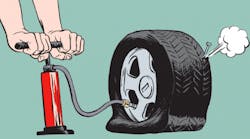Improving Compressed Air System Efficiency: Part 8
Although information abounds comparing many types of industrial machinery, potential buyers of compressed-air equipment have very few resources to aid them in making decisions. It seems as if some compressed-air equipment manufacturers would have the buyer believe that:
• all types and brands are adaptable to a users needs, regardless of the application's specifics.
• the available equipment is the best possible,
• all user problems can be solved by adding more equipment with a minimum of problem definition, and
• there is no independent source of performance certification.
What is left is a confusing situation for the buyer. At best, most systems meet minimally acceptable results. The buyer will often end up making his decision based on which presentation and presenter best represents his company's claims, and what is the lowest price?
Air compressors: 1880 to 1960
Compressors for air came into their own with the development of the steam turbine in the late 1800s. The multiple-stage, multiple-step, reciprocating air compressor was the workhorse of industry for more than 100 years. It has been the more efficient compressor, making more than 5 cfm of compressed air per brake horsepower. At the same time, there were single-stage, double-acting, and two-stage, single-acting compressors. These types of reciprocating compressors are more popular in the smaller sizes (3 to 50 hp). Reciprocating compressors were sold primarily to the industrial and instrumentation markets.
In the 1930s and 1940s, centrifugal and axial air compressors were introduced, to serve a need in the market for larger compressors — primarily for the process and chemical markets. A high flow at a moderate pressure was produced in a relatively small package, compared to the dominant reciprocating compressors. Most of these compressors were built in three- and four-stage formats, and were built one at a time for the application. They were competitive with non-lubricated reciprocating class compressors. In more recent years, manufacturers have learned to package less expensive (and less efficient) two- and three-stage centrifugals to compete in the industrial marketplace. Axial compressors, which competed ineffectively with centrifugals, have all but disappeared from the market.
Compressors: 1960 to present
Prior to the 1960s, each compressor was packaged for the requirements of the system in which it would be installed. The motor, sheaves, belts, flywheel, filters, piping, and coolers were carefully selected and assembled for specific performance. In the 1960s and early 1970s, manufacturers introduced packaged compressors with all of these components mounted on a common frame at the factory. The package included the motor starter and aftercooler-separator with the rest of the components, if desired. This was done for the purpose of economies of scale. The result was a more price-competitive package to sell, requiring less installation cost and labor. The operating performance of these new compressors was 20% lower than the dominant reciprocating type, but the electricity was inexpensive then.
Rotary vane and screw compressors appeared during this period, because of their minimum unbalanced forces and adaptability to factory packaging. This also introduced air compressors that operated as much as 10% above the service factor of the motor. As all previously built compressors were designed to operate at or under the nameplate current of the motor, the units were rated at nameplate horsepower. Users found themselves comparing a 200-hp reciprocating compressor delivering 1,050 cfm with a 200-hp rotary screw compressor that delivered 970 cfm at the same pressure — but at a cost 25 to 35% less for the rotary screw type. The rotary screw compressor looked like the obvious winner.
Continuing this example, however, the reciprocating compressor probably used 195 hp of the 200 hp motor, while the screw compressor probably needed 220 hp from the 200 hp motor — 12.8% more power. The difference in the delivered volume is 10.5%, giving a net difference of 23.3% power to delivery — certainly making the choice between the two less clear.
Compressor controls
Most compressors sold prior to 1970 had to increase pressure to unload. With the inherent packaged losses and the need to use a portion of the service factor at rated performance, modulation became necessary to reduce the volume as the pressure rose, protecting the packages from electrical overload. Load-unload compressors increase in power and density at constant volume as the pressure rises. This control approach requires more power. Modulating compressors, however, reduce flow as the density rises, so the power does not increase.
Modulation was originally marketed as capacity control, while it was actually intended to protect the package from electrical overloading. What came of this feature in time was poorer performance and a need for more compressors. As system demand increased, the pressure would drop. The only way to increase pressure without changing the operating set points of the compressors was to install and operate another compressor. When the new compressor was installed and put in modulation, all of the compressors which were running would share the total demand increasing in pressure. All units that are on would also become part-loaded. The efficiency of the system would drop while the power increased. The part load inefficiency would keep the power high, giving the appearance of more loading than actually exists.
Modulation can be applied more effectively, although this is seldom the case in the field. Service mechanics have encouraged the use of modulation in the name of lower maintenance and improved reliability, while operating costs increase disproportionately. But if the user isn't tracking power, flow, pressure, and cost, none of this is apparent.
Conclusion
Over the past thirty years, the mix of compressors has also changed. Rotary screw compressors have become the predominant type in use in small to moderate sized facilities. Reciprocating compressors have all but vanished in new sales of larger sizes. Today, single- and two-stage rotary screws have replaced single- and two-stage, double-acting reciprocating compressors. Two-stage non-lubricated screw compressors have replaced larger non-lubricated reciprocals. Two- and three-stage packaged centrifugals have replaced the largest size reciprocating and four-stage centrifugal compressors. There are only a few vane compressors left in the market, which generally compete against smaller screw compressors and two-stage, single-acting reciprocating compressors.
The current state of the compressor business is a more commercial approach with a strong focus on reducing the manufacturing costs of products sold. Technical integration, systems engineering, and demand control are practically non-existent. A few manufacturers provide education and services in these areas, although they are the exception rather than the rule.
At distribution levels, it has become more difficult for end-users to apply compressors, when cost effectiveness is an important issue. Utility costs are substantially higher, and global competitiveness has increased, which has driven a need in the market that has only been fulfilled on a very limited basis.
Compressors and frame sizes
An important issue that is often overlooked is the frame sizing of packages. Manufacturers design a series of frame sizes, each of which holds a range of compressor sizes. A manufacturer which makes 15 different compressor sizes ranging from 3 to 150 hp would not want to create 15 different standard frames. Instead, it might divide the sizes into five different frames. Compressors of 3, 5, and 7.5 hp could fit in the smallest frame size, while the next frame would accommodate the 10, 15, and 20 hp compressors, and so on. A manufacturer usually puts two to five different sized compressors on one packaged frame size. As the volumetric displacement increases in the package, the cost of the package does not increase linearly. The idea is to minimize the basic bills of material and reduce the inventory requirement, while serving a wide range of sizes.
A disadvantage, however, is efficiency losses. The bottom of the frame would have relatively good performance, while the top of the frame would have poor performance. (This includes packaged pressure losses.) As the flow increases, the differential across the same components increases as the square of the flow increases. Maintenance, filter life, operating temperatures, and achievable pressures at rated flow can all be variables, depending on where a particular compressor size falls in a frame size.
Most manufacturers have different approaches to how they design for frames. Some will have a wide range of volume and pressure, while others are more conservative. Different manufacturers will have the same offering in different frame positions. An interesting problem for the user is that one manufacturer may have a particular size in the top of the frame, while the competitor has the same size in the bottom of their frame. The rate performance will appear to be similar, but the internal performance will be different. The one in the top of the frame will have a lower manufacturing cost and will be able to be more competitive in their selling price.
Recently, there has been more effort to arrange frame sizes so that the most popular sizes sold are at the top of the frame for the sake of competitiveness. Some manufacturers who have found themselves non-competitive in a size at the bottom of the frame will add a similar size compressor offering at the top of the next smaller frame. This is called "stretching a frame." Most compressor manufacturers have very different approaches toward this issue. The difficult part for the buyer (and often the manufacturer's field representative) is that the manufacturers do not discuss or provide information about frame sizing.
R. Scot Foss is president of Plant Air Technology, Charlotte, N.C., which specializes in air system auditing and design. This series of articles is based on his book, Compressed Air System Solution Series. To order a copy, click here.

